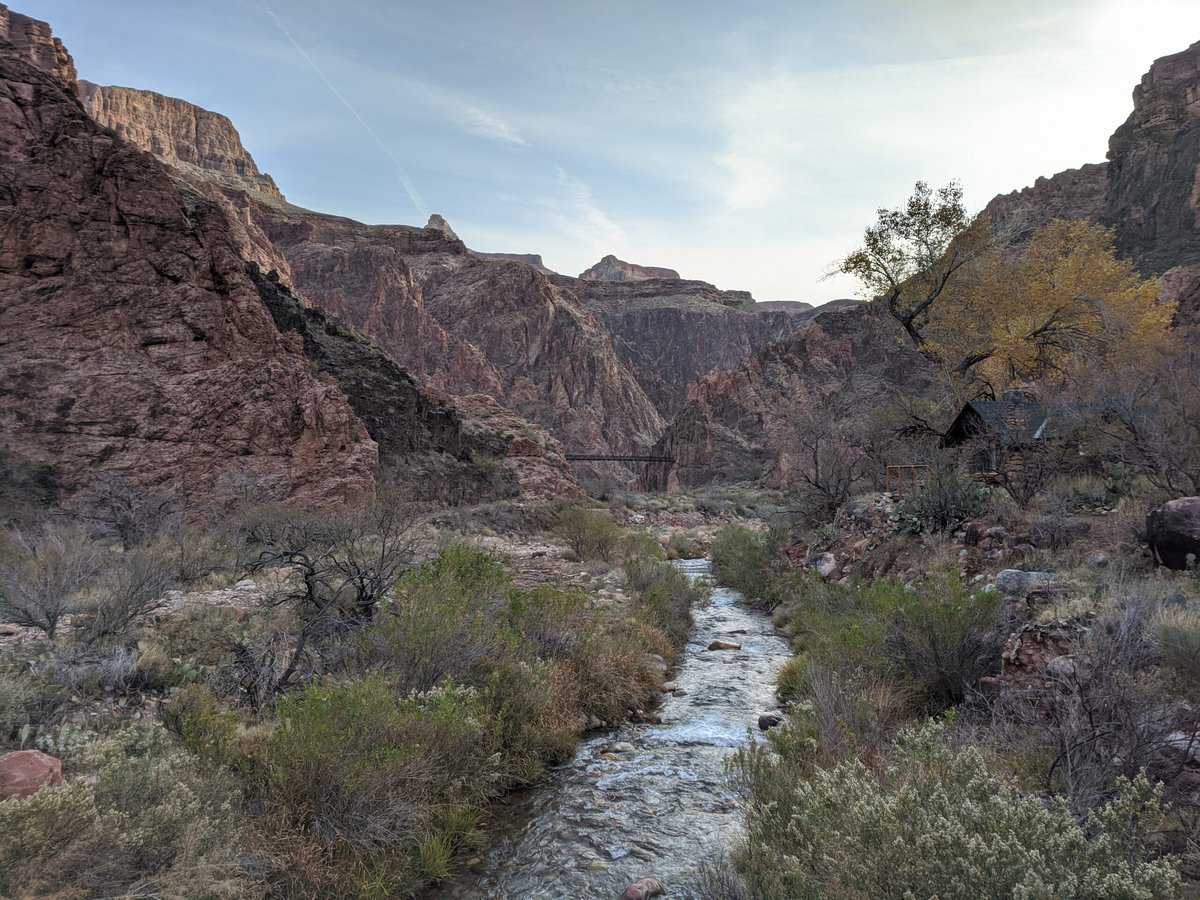Last updated on April 22nd, 2025 at 12:22 pm

Looking for an insider’s guide on how to hike to the bottom of the Grand Canyon? Perfect, we’ve got you covered!
Hi there! I’m the Locals Know Best podcast host, Cindy.
I am a massive fan of outdoor adventure. I have spent years exploring, including time as a full-time RVer and Appalachian Trail thru-hiker. Years of adventuring have taught me one fundamental lesson: locals ALWAYS know best.
Locals Know Best Podcast Ep. 007: Grand Canyon Hike to Bottom
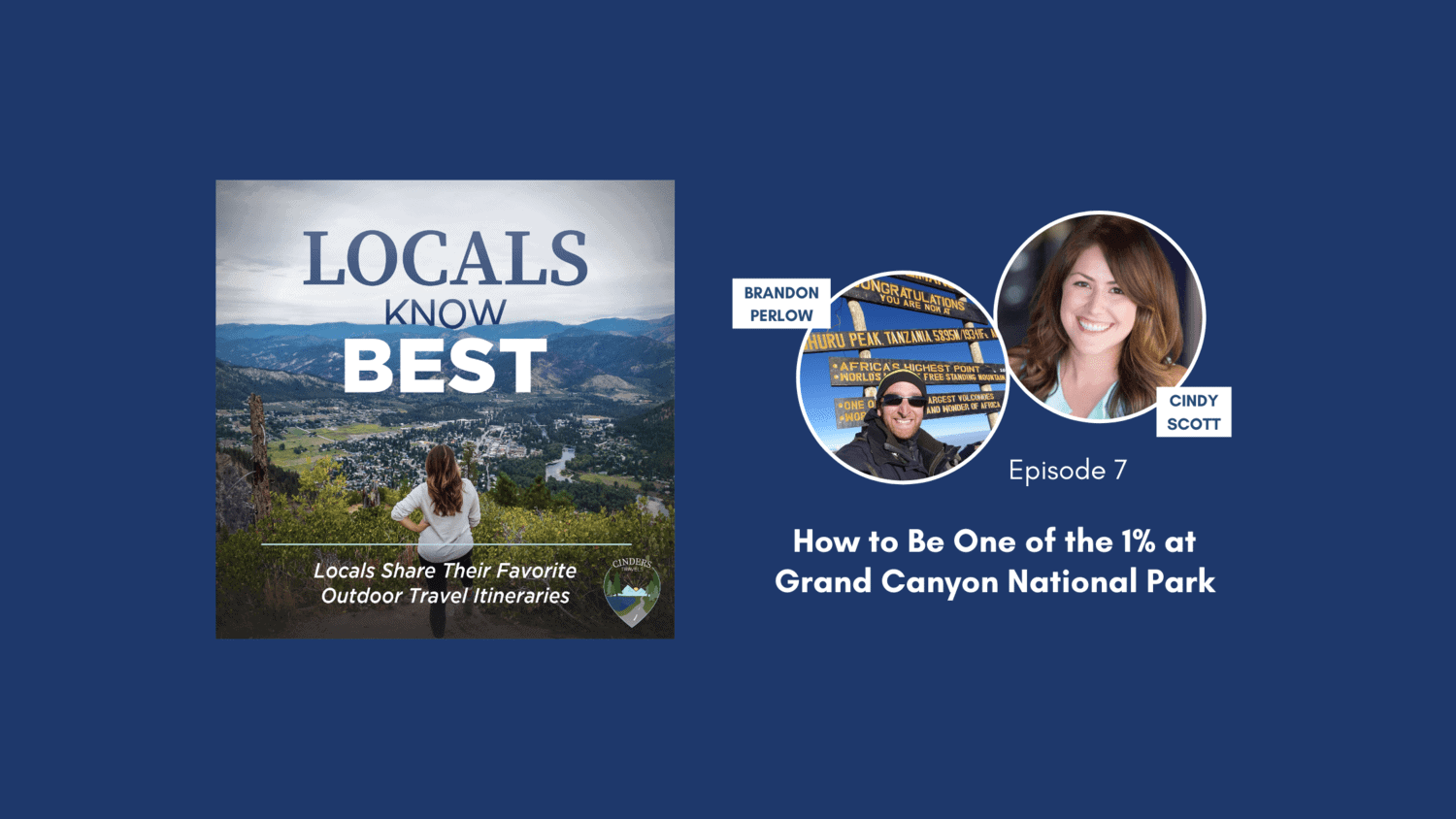
This article summarizes the seventh episode of the Locals Know Best podcast!
Every podcast episode dives into one local’s perfect day of outdoor adventure in their area.
This episode embraces being outdoorsy in Grand Canyon National Park, with a particular focus on hiking to the bottom of the Grand Canyon and back!
Join local insider Brandon and me as we discuss insider tips for visiting the Grand Canyon and hiking to the bottom and back, something only 1% of visitors do!
Join Brandon and me on an engaging journey down through multiple levels of Grand Canyon National Park, exploring all the best stops, lookouts, and places to stay along the way!
Listen to the Episode
Click here to listen to this episode of Locals Know Best!
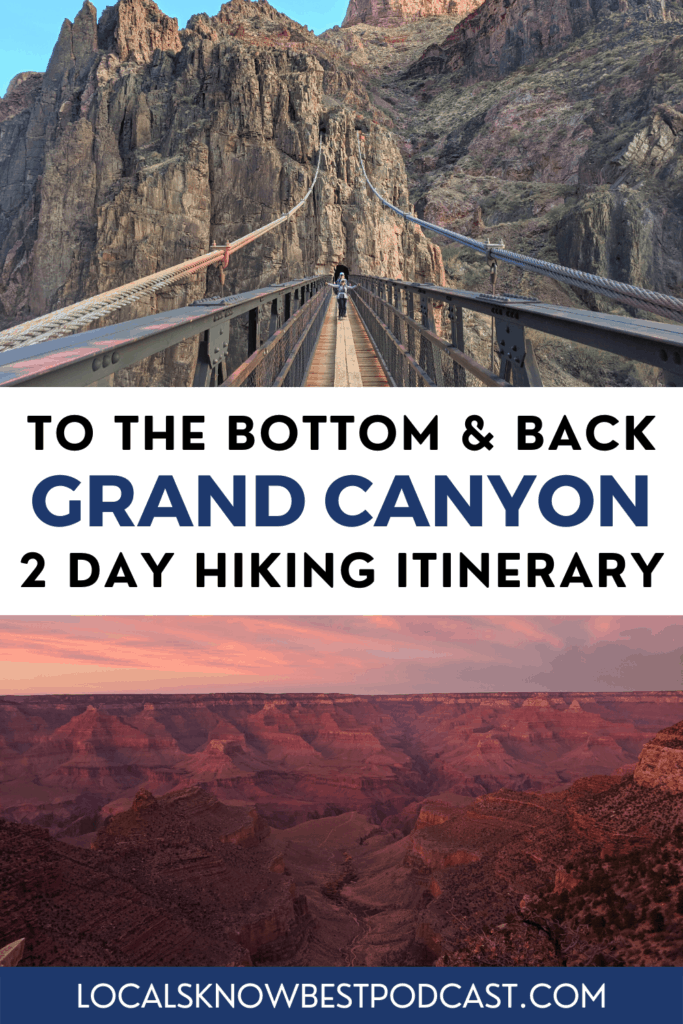
About Brandon Perlow
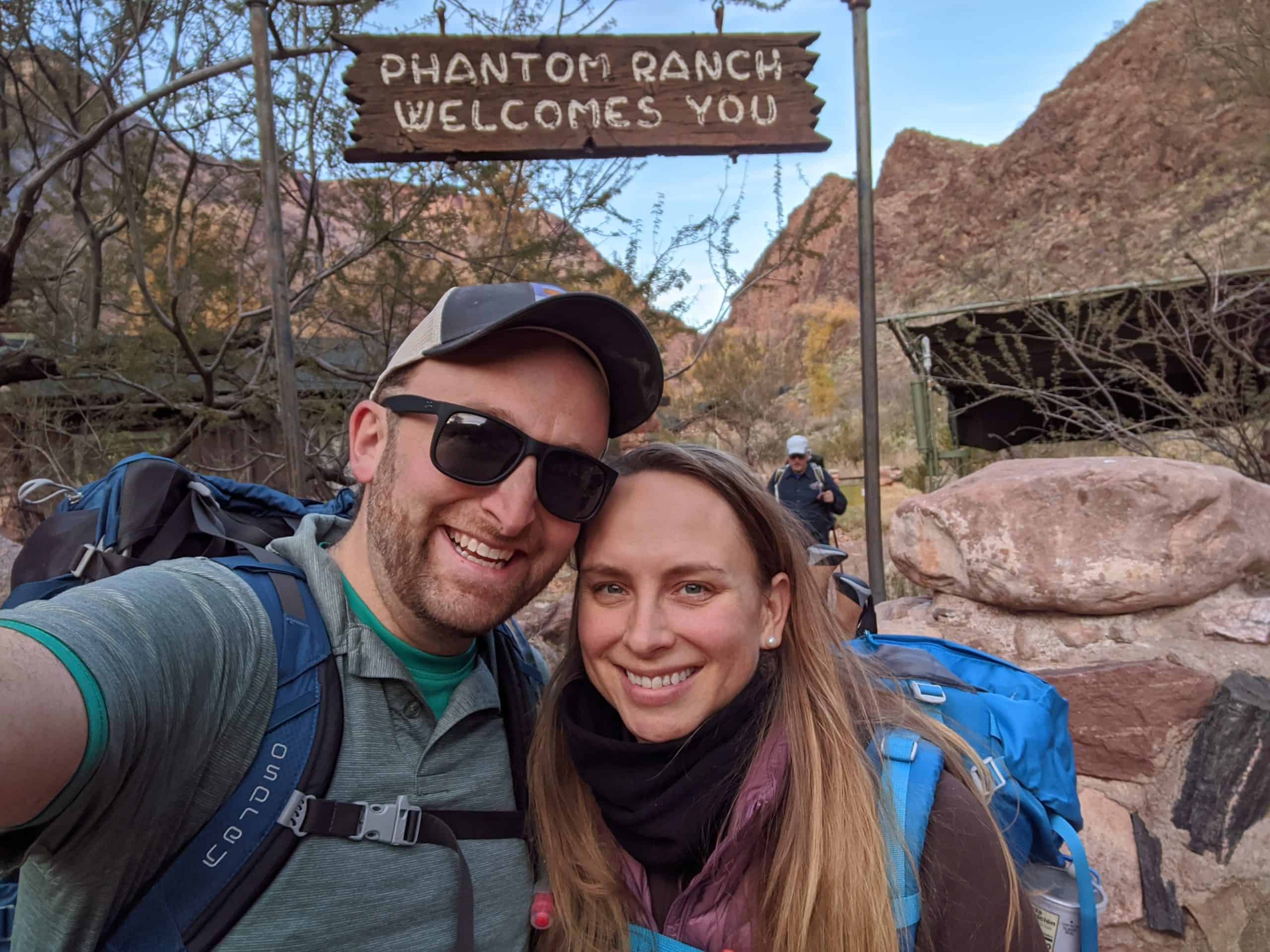
Brandon Perlow is an avid traveler and adventure-seeker. He’s been to all seven continents and all 50 states and has lived abroad as well as across the country. He’s run ultramarathons, climbed Kilimanjaro, and navigated class five whitewater rapids.
These days, he calls Arizona home with his family, and he chose Arizona largely because of the incredible outdoor adventures available. Of those many options, only one reigns supreme: Grand Canyon National Park.
About Grand Canyon National Park
Brandon opens the episode by sharing his love for the Grand Canyon. To him, there’s nothing better than spontaneously jumping in the car and heading to the national park, dedicating plenty of time to explore its beauty.
Even if you’ve seen the Grand Canyon in movies or on posters, Brandon insists that being there in person is an entirely different experience. He talks about the joy of soaking in the views, watching birds soar, and feeling the rush of the wind. It’s something exceptional.
Planning a Hike to the Bottom of the Grand Canyon
Before heading down to the bottom of the Grand Canyon, there are several things you’ll need to consider.
You’ll need to get a permit in advance, plan your route, gather your supplies, and more.
Keep reading to learn all the details for a successful trip.
How to Get to Grand Canyon National Park
There are three primary entrances to access Grand Canyon National Park.
The South Entrance is approximately 6 miles north of Tusayan, Arizona, where an airport offers flights. From there, you can take a rail service to the South Rim.
Another option is the East Entrance, located about 35 miles west of Cameron, Arizona, which requires driving to enter the park.
Finally, the North Rim Entrance, situated 30 miles south of Jacob Lake, Arizona, also requires driving for park entry.
Grand Canyon National Park Entrance Fee
It’s worth noting that an Entrance Fee is required for entry into the national park.
The fee is $35 for a private vehicle or $30 for a motorcycle.
Or, for $80 ($20 for seniors aged 62+), get an America the Beautiful pass, which covers admission to all US National Parks for one year.
Things to Know about Hiking in the Grand Canyon
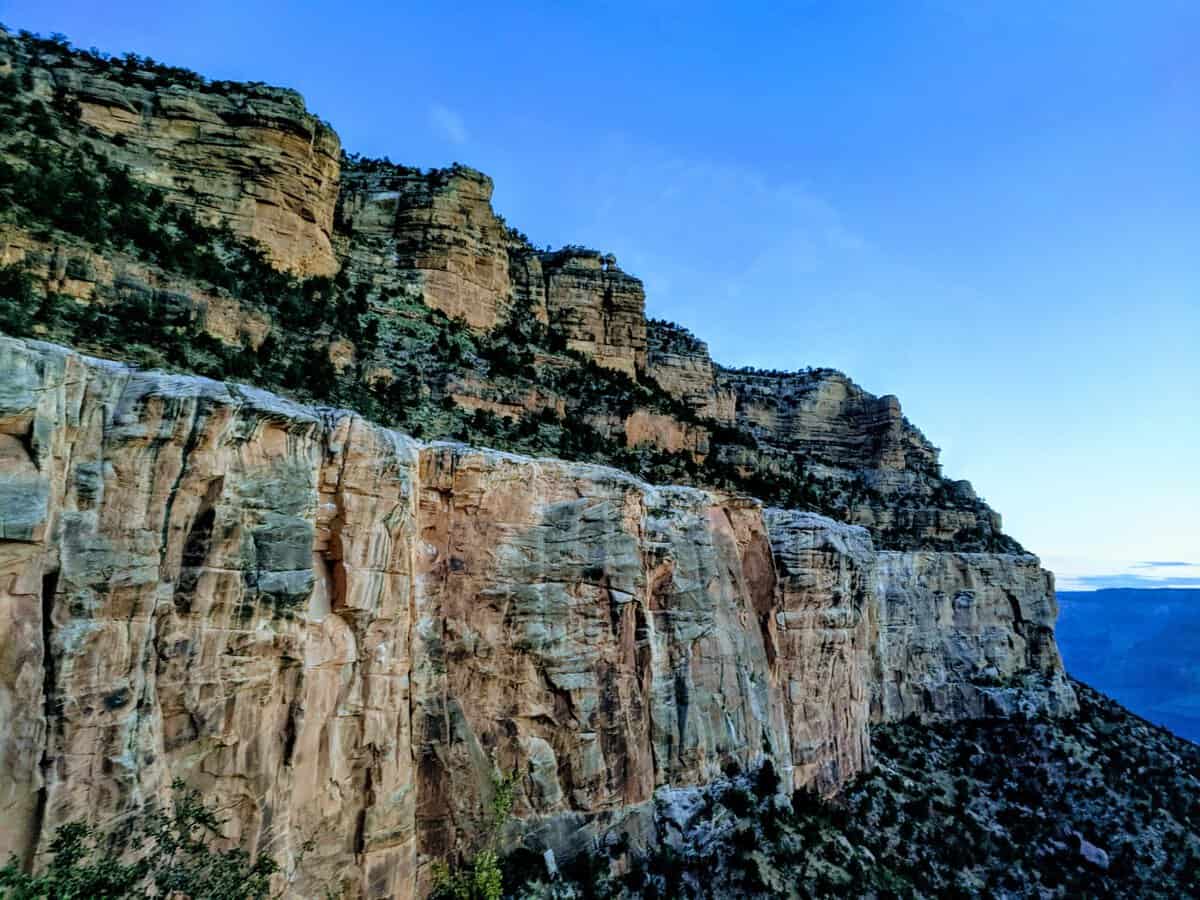
Here are some essential things to know about hiking in the Grand Canyon. Keep reading below as I outline a few important points.
Map and Backcountry Hiking Brochure
Before starting your Grand Canyon adventure, I highly recommend checking out the National Park Service website. They have a fantastic Map and Backcountry Hiking Brochure. It offers valuable tips for hiking, a list of essential items to pack, seasonal details, including temperatures and elevation information, and much more.
It’s a perfect resource for planning your first backcountry hike in the Grand Canyon.
Hiker Express Shuttle
Parking at most Grand Canyon trailheads isn’t an option, so you’ll need to take the Hiker Express Shuttle to your chosen trail. This shuttle starts early from three spots in the Grand Canyon Village and goes to the South Kaibab Trailhead.
Keep in mind, though, it’s only a one-way ride, so you’ll need to plan your return. Check the Hiker Express Shuttle website for bus times, routes, and more details.
Critical Backcountry Updates
One of the most important things to do before your backcountry hike in the Grand Canyon is to check out the Critical Backcountry Updates. This website details trail conditions, heat warnings, lightning risks, and more.
Be sure to visit this site before your hike to stay informed and prepared for your adventure.
The Best Time of Year to Hike to the Bottom of the Grand Canyon

Brandon suggests that the best time to hike to the bottom of the Grand Canyon is during the winter season, even though you might encounter some snowfall.
November hiking offers a pleasant experience. Starting with temperatures near freezing but typically around 40 degrees, it gets warmer as you descend, potentially exceeding 80 degrees, striking the perfect balance between not too cold and not too hot.
Due to the moderate temperatures, late fall and early spring are considered the peak seasons for hiking to the Grand Canyon’s bottom.
However, Brandon advises against attempting the hike during summer because of the intense heat within the canyon. The inner canyon, known as “The Box” by locals and avid hikers, can feel scorching, reaching up to 115 degrees in the shade, and can feel like an astounding 140 degrees on your skin, making it uncomfortably hot. While summer is a great time to explore the rim, Brandon strongly discourages descending to the bottom during this season.
Regardless of when you plan your visit, it’s important to note that the Grand Canyon has a desert climate, which results in frigid temperatures at night and in the morning. So, packing plenty of layers is essential for a comfortable experience.
How to Obtain Permits for Multi-Day Hiking Excursions in Grand Canyon National Park
You are required to have a permit for hiking excursions in the Grand Canyon that require an overnight stay.
Camping Permit Request
To obtain a permit, you must complete one application per group and submit it ahead of time to the Backcountry Information Center via fax, mail, or in person.
For the highest likelihood of approval, submit your application by the 1st of the month, four months before your planned start date. Permit approval is determined through a lottery system during the allocation process.
Before applying, visit the Camping Permit Request website for additional information and details.
The Best Hiking Route to Get to the Bottom of the Grand Canyon
It’s not recommended to attempt a one-day hike to the bottom and back due to the strenuous nature of the journey. According to the National Park Service, a minimum of two days is recommended for the round trip.
Despite some people ignoring this advice, Brandon, a local and Grand Canyon hiking expert, strongly encourages listening to the recommendations of the National Park Service and Rangers.
When hiking in a canyon, it’s essential to understand that it differs from hiking up a mountain.
If fatigue sets in when hiking up a mountain, you can simply turn around and descend safely.
However, the easy descent is the first part of hiking into a canyon. So, if fatigue hits and you decide to turn around, you’ll face a tougher challenge of climbing out of the canyon.
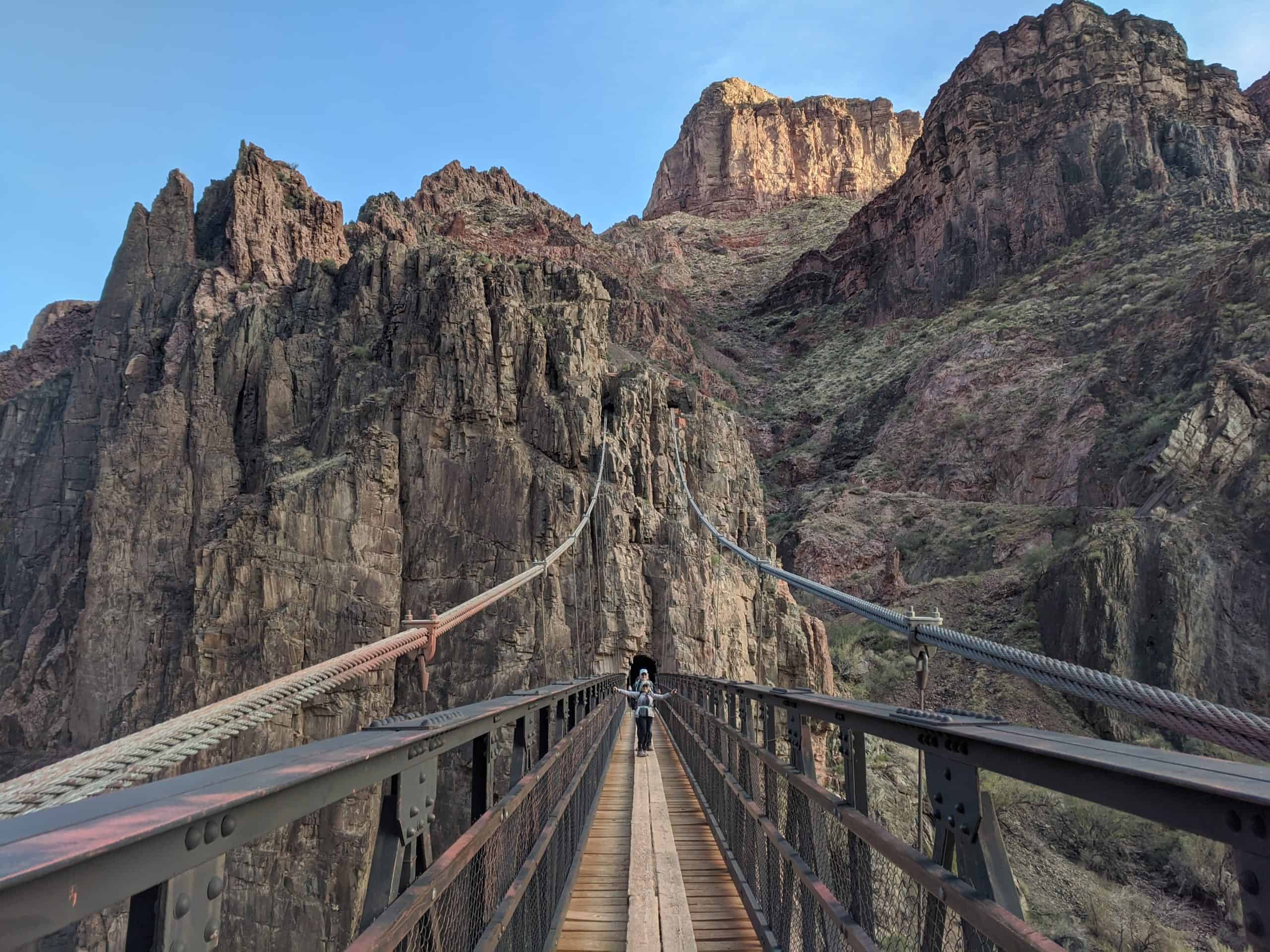
Brandon and I suggest completing the journey to the bottom of the Grand Canyon and back over two days.
Here’s an outline of the ideal hiking route:
Day One: South Kaibab Trail
The best way to reach the bottom of the Grand Canyon is by using the South Kaibab Trail, which spans roughly 7.5 miles and leads to Phantom Ranch.
Day Two: Bright Angel Trail
On the second day, your route would be from Phantom Ranch to the Bright Angel Trailhead, covering a distance of around 10 miles.
Eating
For any backcountry hike, it’s crucial to plan your meals ahead. You must pack enough snacks, breakfast, lunch, and dinner to fuel your energy throughout the journey.
For a two-day hike, you’ll likely have breakfast before starting your journey. Then, you’ll need lunch and dinner for the first day, followed by breakfast and lunch for the second day. Typically, you’ll finish before dinner on the second day.
Additionally, ensure you bring plenty of energy-rich snacks that are easy to consume while hiking.
Brandon suggests bringing easy-to-eat snacks like Pringles or a Snickers bar.
A unique feature of hiking to the bottom of the Grand Canyon is the Phantom Ranch Canteen. Next, I’ll give you some insights about this unique backcountry destination and how using it can affect your backpack load.
Phantom Ranch Canteen
One must-have treat when you reach the bottom of the Grand Canyon is the Phantom Ranch Lemonade. There’s nothing quite like it after trekking down miles of canyon trails. Even if you’re not staying overnight at Phantom Ranch, it’s worth stopping by for some refreshing lemonade.
If you’re interested in having breakfast, lunch, or dinner, you can pre-order your meals at the Phantom Ranch Canteen and collect them upon arrival. It’s important to note that all orders must be placed in advance; no on-site ordering is available.
This option is particularly convenient if you prefer to avoid carrying a portable stove to heat water. Additionally, if you opt to pre-order a meal at the Phantom Ranch Canteen, you can pack less food for your hike.
Where to Stay at the Top of Grand Canyon National Park
El Tovar Hotel
The El Tovar Hotel is one of the best places to stay in the area. The hotel originally opened in 1905, which makes it older than since the Grand Canyon was designated a National Park. The hotel is a National Historic Landmark and has some of the most incredible views of the Grand Canyon from some of its rooms. It’s the perfect place to stay before or after your hike.
Bright Angel Lodge
Here’s another top-notch accommodation option, complete with an ice cream parlor. It’s the perfect spot to relax after trekking to the bottom of the Grand Canyon and reward yourself with a special treat for all your efforts.
Where to Park at the Top of Grand Canyon National Park
Parking on the South Rim of the Grand Canyon is relatively simple. Follow signs to the South Rim Visitor Center Plaza, where four parking lots are available. It’s a good idea to take a photo of the parking lot sign to remember where you parked. Once parked, you can either walk to your destination or hop on one of the free shuttle buses to reach your desired location.
Where to Stay at the Bottom of Grand Canyon National Park
There are limited choices for accommodations at the bottom of the Grand Canyon, so continue reading as I provide information on each one.
Phantom Ranch
Phantom Ranch is a cozy lodging option located at the base of the Grand Canyon. It includes a small Canteen where you can schedule meals in advance online.
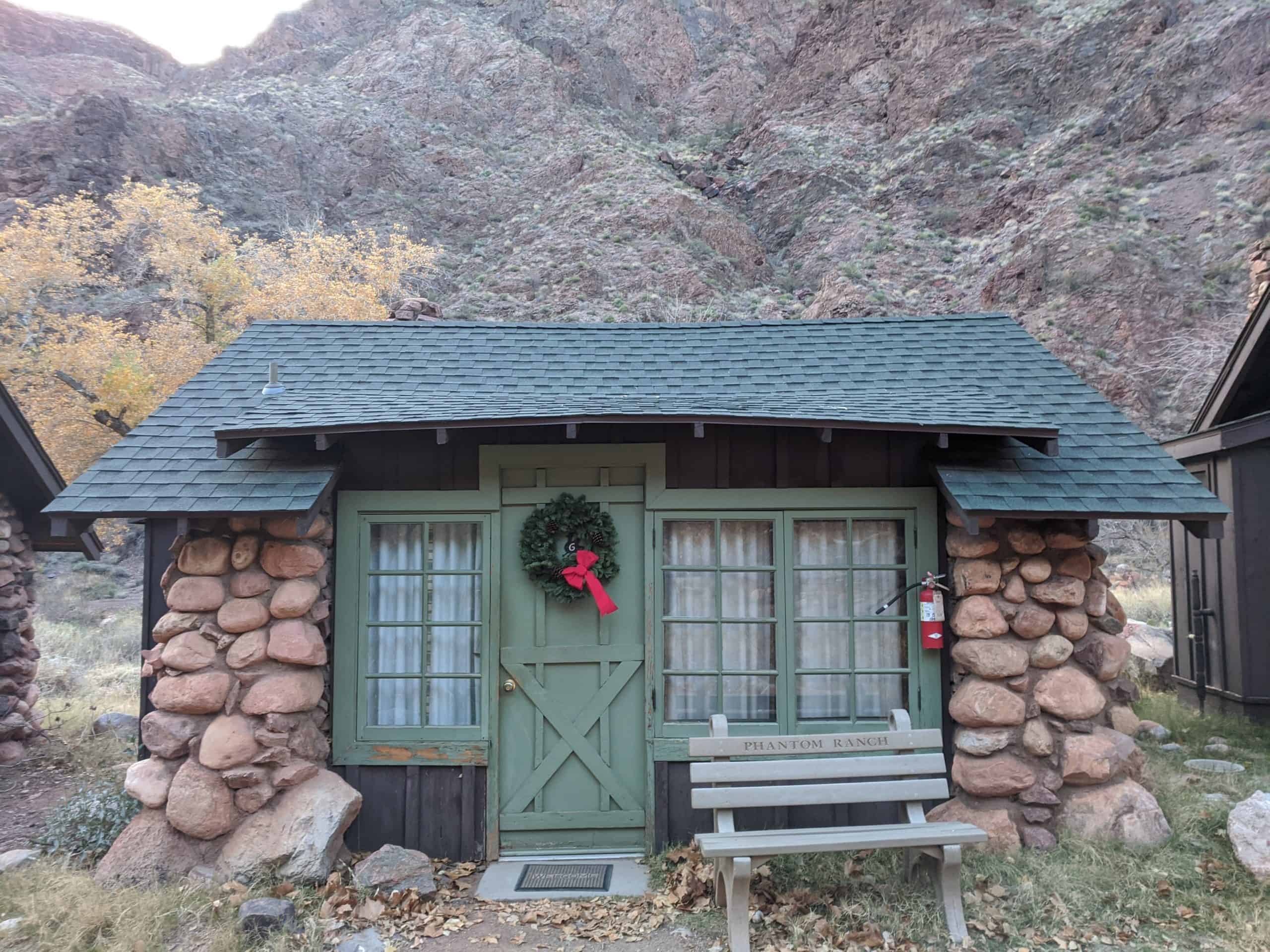
Phantom Ranch Facilities
Phantom Ranch offers two main types of lodging: dormitories and cabins. There are separate dorms for males and females, each equipped with five bunk beds, a shower, and shared bathrooms. Cabins accommodate 2 to 10 guests and include a sink and toilet.
How to Book a Stay at Phantom Ranch
You must participate in a lottery system to secure accommodations at Phantom Ranch.
I suggest visiting their website for detailed information on the reservation process and lodging options.
Phantom Ranch Lottery Cancellations
Are you perhaps looking for a way to score last-minute Phantom Ranch accommodations at the bottom of the Grand Canyon?
If you’re not selected in the Phantom Ranch Lottery, there are still opportunities to secure last-minute reservations. Winners of the lottery can cancel their bookings up to 45 days before their visit, with most cancellations occurring between 45 and 60 days prior.
General availability for the current month is released on the first of each month.
For instance, on November 1st, any openings for the entire month of November may become available if there are cancellations, so I recommend regularly checking their website for updates.
However, it’s important to remember that reservations within 45 days are nonrefundable.
Camping
Backcountry camping at the Grand Canyon requires a permit. There are three campgrounds: Indian Garden Campground, Bright Angel Campground, and Cottonwood Campground.
Tips for Hiking to the Bottom of the Grand Canyon
The journey to the bottom of the Grand Canyon and back is demanding, and there are some crucial tips, along with essential items to pack, that you should keep in mind.
Water
Make sure to bring at least 3 liters of water when you start your hike.
An important tip Brandon suggests is going down the South Kaibab Trail because it usually requires less water downhill, and there’s no water to refill on that trail.
For the way up, he advises taking the Bright Angel Trail, where you can refill.
Remember that even though there’s usually plenty of water, it’s not guaranteed because pipes might break. Brandon suggests bringing iodine tablets or a water filter to purify water from places like rivers to be safe.
Packing Suggestions
It is important to have all the necessary gear, including camping equipment, clothing, food, and more, for any backpacking trip. Check out my complete backpacking gear list for recommendations on packing all the essentials without overpacking or forgetting anything.
What to Wear
What you wear for hiking to the bottom of the Grand Canyon depends on the time of year. I recommend wearing long sleeves and pants to protect your skin from the terrain and the sun. It’s best to choose breathable fabrics and have a short-sleeved shirt or tank top underneath so you can adjust layers as needed.
Pack extra layers for cooler mornings and nights, as the desert climate can get chilly after sunset.
Trash & Leave No Trace
Always remember to follow Leave No Trace principles. Avoid leaving any litter or garbage behind when hiking on trails. It’s crucial to preserve the beauty of our National Parks by keeping them clean and well-maintained.
The Best Grand Canyon National Park Picture Spots
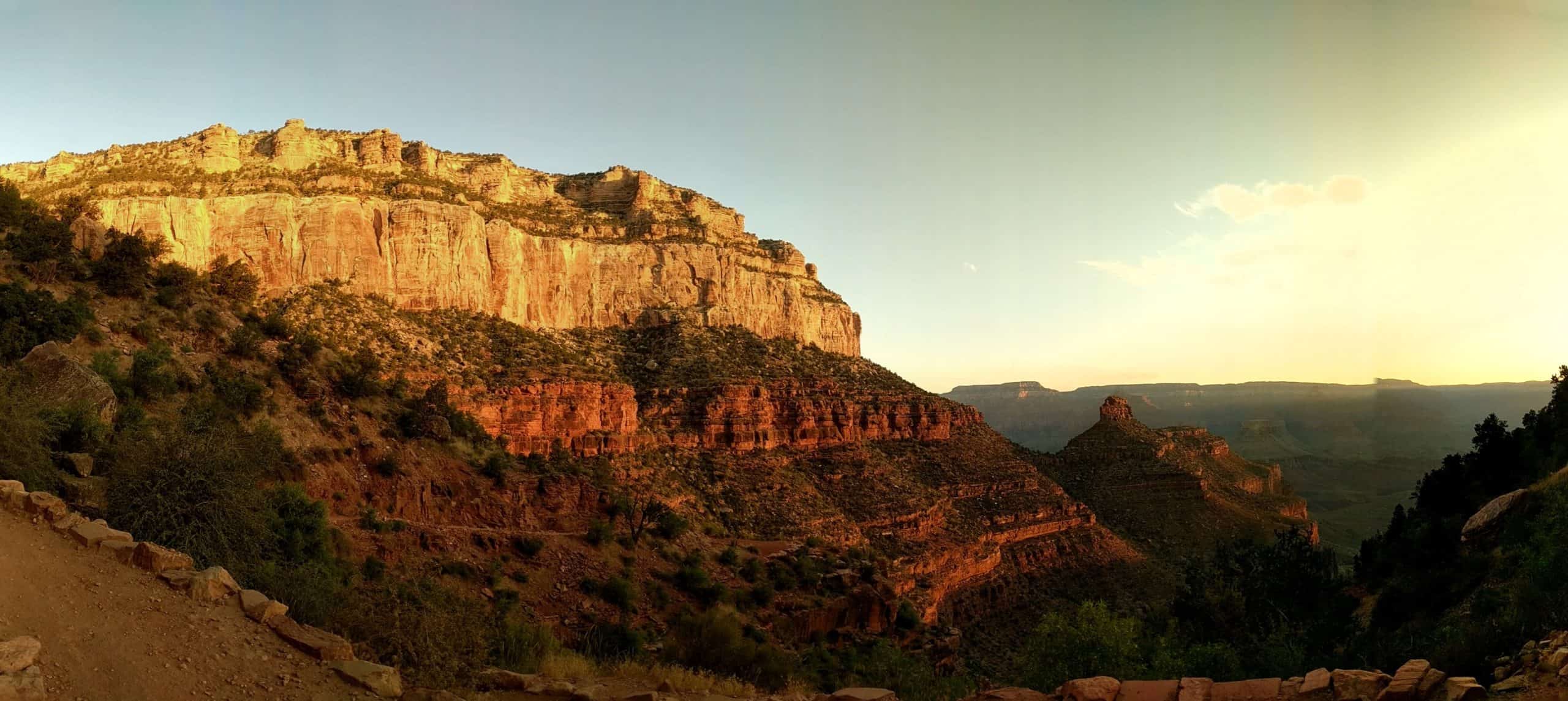
For the best photo opportunities in Grand Canyon National Park, be sure to visit these top spots:
📸 Start your adventure at Ooh Aah Point for incredible views and a fun hike.
📸 Mather Point is also a must-see, offering some of the park’s most popular photo opportunities.
📸 Additionally, don’t miss the chance to capture stunning images at Lipan Point.
These spots promise memorable snapshots of the Grand Canyon.
Brandon also notes in the podcast that, ultimately, anywhere along the rim is gorgeous, and there really is no bad place to take a picture of the Grand Canyon! The Rim Trail covers 13 miles of lookouts along the rim, from South Kaibab to Hermits Rest. It’s more of a touristy area, but it still provides spectacular views.
Overrated Spot
While the Grand Canyon’s fame in movies and conversations might make you think it’s overrated, Brandon and I firmly disagree. Each spot offers breathtaking views that you can only fully appreciate by experiencing them firsthand.
The Grand Canyon has no overrated spots because every view is stunning. However, if you want a fresh perspective and a unique angle of the Grand Canyon, consider hiking into the canyon at least a bit to appreciate the views from a different angle.
Other Things to Do
If you prefer something less time-consuming and easier, several other hikes in the Grand Canyon offer stunning views.
The South Kaibab Trail to Cedar Ridge spans about 3 miles round trip. It’s considered moderately challenging, with an elevation gain of nearly 1,200 feet. This hike is ideal if you have 2 to 3 hours but still want to enjoy impressive views not visible from the rim.
For a more challenging option, consider the South Kaibab Trail to Skeleton Point. This strenuous hike covers about 6 miles round trip, gaining over 2,000 feet in elevation. It offers a rewarding experience of the inner canyon without descending all the way to the bottom.
Other Ways to Reach the Bottom of the Grand Canyon
Apart from hiking, there are other ways to reach the bottom of the Grand Canyon. You can ride a mule, go river rafting, or drive your vehicle by taking Diamond Creek Road. Each option provides a unique experience and lets you appreciate the canyon’s beauty differently.
Grand Canyon Tours
FAQs:
Next, I’ll answer a few frequently asked questions about visiting Grand Canyon National Park.
How Long Does it Take to Hike to the Bottom of the Grand Canyon?
It takes about 5 hours to hike to the Bottom of the Grand Canyon.
Can You Hike to the Bottom of the Grand Canyon and Back in One Day?
While it is possible to hike to the bottom of the Grand Canyon and return in a single day, it is not recommended.
Both park rangers and experienced hikers strongly discourage attempting the hike in one day due to its strenuous nature and potential safety concerns.
Is it Worth it to Hike Down the Grand Canyon?
It is totally worth it to hike down the Grand Canyon. The views are insane as you make your way into the inner canyon and take in the sights from down below.
Do You Need a Permit to Go to the Bottom of the Grand Canyon?
A permit is required to go to the Bottom of the Grand Canyon because the journey requires overnight camping.
Are there shuttles from Las Vegas to the Grand Canyon?
There are shuttles from Las Vegas to the Grand Canyon. Be sure to check out the National Park Express.
Can You Get From Las Vegas to the Grand Canyon and Back in One Day?
It is possible to travel from Las Vegas to the Grand Canyon and back in a day, but it will be a full and busy itinerary. You can drive your own vehicle or join a full-day tour.
Here are some full-day tour options from Las Vegas:
Is the South Kaibab Trail or the Bright Angel Trail easier?
The Bright Angel Trail is known to be easier than the South Kaibab Trail.
Will My Cell Phone Work in the Bottom of the Grand Canyon?
No, your cell phone will not work at the bottom of the Grand Canyon.
Grand Canyon National Park Two-Day Hiking Itinerary Map
Conclusion:
Hiking to the bottom of the Grand Canyon offers an incredible adventure filled with breathtaking sights and unforgettable moments. It’s critical to listen to local advice, like Brandon’s, and come prepared with the necessary supplies and knowledge.
Whether you choose the South Kaibab Trail or another path, take your time, stay hydrated, and soak in the natural beauty surrounding you.
This journey is not just physically rewarding but also an overall incredible experience, connecting you with nature.
Would You Rather Listen to This Information? Give the Podcast Episode a Listen!
Click here to listen to this episode of Locals Know Best!
Thanks for Listening!
We love our listeners! If you’ve enjoyed the show, please consider leaving the episode a review in Apple Podcasts. It’s super easy; click here and go to “ratings and reviews.” I read and appreciate every single one! Each review helps new listeners find the podcast. Thank you!!
Follow Cinders Travels on Facebook or Instagram for Locals Know Best updates.
Pin it for later:
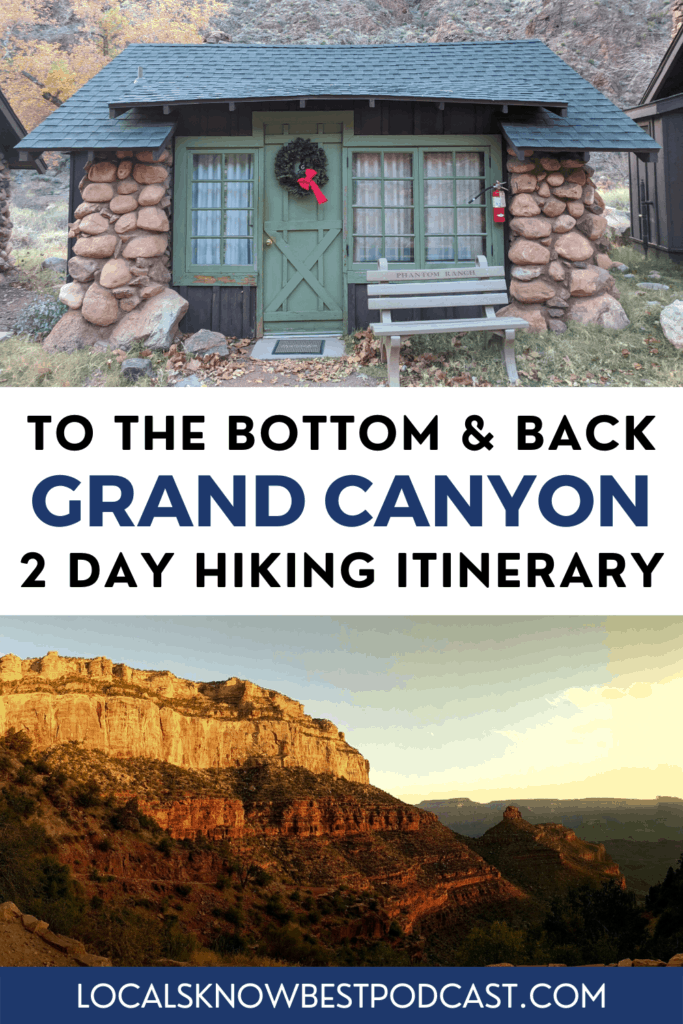
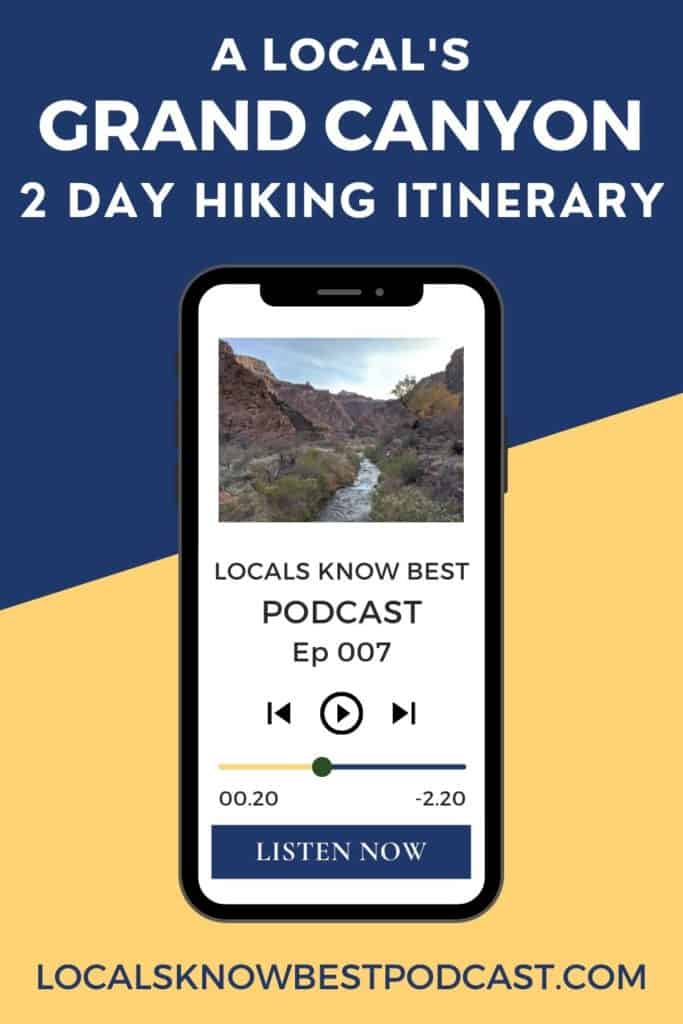
You May Also Enjoy:
- Locals Know Best Podcast Ep. 028: That Cabin Cozy Feel in Flagstaff, Arizona
- Locals Know Best Podcast Ep. 002: Playing Beneath the Mountains in Colorado Springs, Colorado
- Locals Know Best Podcast Ep. 029: Kenai, Alaska, You’ve Entered the Real Alaska

